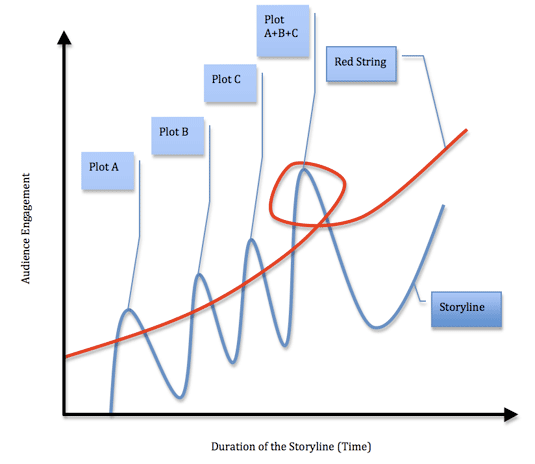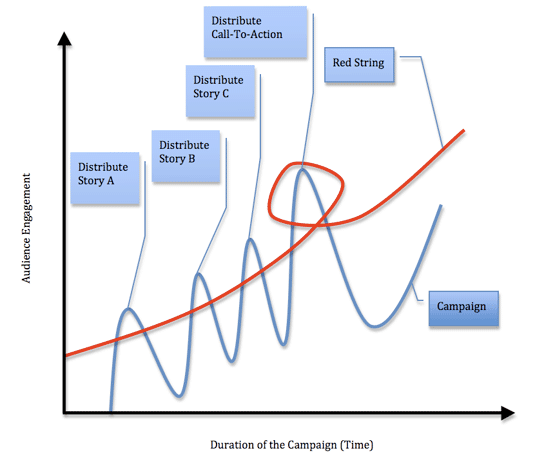So what is the Red-String when it comes to telling a story? Hmm…well it is the underlying theme that connects all the layers within a story. Bob Dotson of NBC’s American Story talks about telling a good story. A good story is one that is memorable…one with layers. Layers of individual stories bound together by an underlying theme or story-line, hence the “Red-String.”
Think about the best book you have ever read, or one of your favorite movies. It is a bigger story built around little micro-stories connected together by a “Red-String.” Each little scene or story is placed ever so appropriately at the right place, at the right time, in the right sequence to build and “argument” or thought.
Let’s take a look at the “Red-String,” as it is shown here graphically. This is the only way I know how to explain this concept.
As you notice the relationship is somewhat of a linear relationship between the audience’s engagement and time. Over a period of time, the story-line is moving along as the audience engagement increases during each micro-story or plot. As the story-line moves along, the audiences engages with some intensity during the rising and falling actions of each plot. As the story progresses through each plot, from one to the next, it is held together and connected by the “Red-String.”
At a specific point, at the right time…the author brings all the plots together with a reveal or rising action. This is where the “Red-String” ties the knot bringing all the story-lines together reveal the bigger picture, the main plot-line.
So this translates directly to any marketing campaign. It is my opinion that any effective marketing campaign capitalizes on building relationships with target audiences, delivering small messages over time. These messages build to a bigger “reveal” or “call-to-action.” These messages are little stories, micro-stories connected by the underlying theme of the campaign, or the “Red-String.” The point where the main “call-to-action” is placed is at the right time when the “Red-String” ties the knot.
Social Media Technologies are just another technology that is added to the bag of tricks; but what they really are….they are just distribution points. Some professionals refer to them as connection points, a point that allow users to interact with distinct audiences. Social Media outlets are just a bit different because they carry one inherent value that closely relates to word of mouth marketing, they use relationships as driving force. To build engagement, your must build trust…to decide to become a “friend,” “fan,” or “follower.”
The “Audience Engagement” axis is extremely important part of this discussion. Lots of professionals create Social Media “accounts” and immediately start marketing the goods/services. Unless you are “Hot” brand…you need to spend time building audience engagement before implementing an effective “call-to-action” campaign.
This is where the idea of “listening” is so critical. As in any relationship, trust has to be gained and the relationships have to be forged. As the trust builds, and the conversation increases, the audiences grow. And slowly over time, the stories can be distributed to create an awareness for the campaign. This is where the true effectiveness of the “Red-String” ties the knots of the stories, the campaigns, the message.
So in the world of storytelling, are you telling those stories that are connected by the “Red-String?” Is your campaign relevant or just a bunch of little messages with no direction, purpose, of relevant placement. What is the “Red-String” in your campaign?




